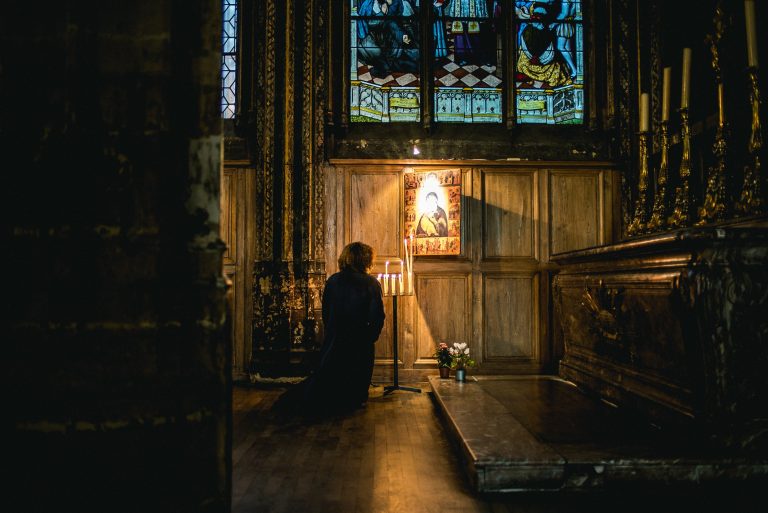By Emily Stimpson Chapman

Understanding the connection between the theology of the body and liturgy, between the theology of the body and prayer, begins, like most everything else, in the Garden.
From the beginning, God made man as a union of body and soul, and so when man fell, he fell as a union of body and soul. Concupiscence invaded his heart, which “depersonalizes man, making him an object ‘for the other’” (The Theology of the Body 32:6), while sickness, pain, and death took hold of his flesh. Both felt the effects of Adam’s sin. Both were wounded. So both needed to be healed. Both needed to be incorporated into the process of redemption. Only then could man enjoy an eternity with God as man, as a union of matter and spirit.
In dying an rising, Christ paid the price for man’s sin and won the graces for that two-fold redemption. But those graces still needed to be applied to men as individuals. Men had to “put on Christ” and be redeemed (Rom 13:14). To do that, God gave us the sacraments.
If your grade school catechesis was better than mine, you’ll recall that the textbook definition for the Catholic sacraments is “efficacious sign.” Of those two words, “sign” is the easy part to understand. It tells us that the sacraments rely on natural symbols to signify supernatural realities. Each symbol communicates or helps us understand what the sacrament does for us. They do that by employing matter and movements that, in the natural order, do to our bodies what, in the supernatural order, they do to our souls.
For example, the water used in Baptism is a natural sign of cleansing. That’s what water does: it cleans things. Similarly, the bread and wine in the Eucharist are natural symbols of nourishment. Again, that’s what bread and wine do: they nourish us. Kneeling, like in the confessional, is a natural sign of contrition. It’s what we do when we’re begging someone’s forgiveness. Then there’s the oil used in Confirmation. In days of old, people rubbed oil on the bodies of athletes to help them prepare them for competition, believing it would strengthen them. Oil was used to anoint persons, such as prophets and kings, strengthening them for their divinely appointed task of service.
In the sacraments, the use of those natural symbols helps us perceive spiritual truths. They reveal meaning to us in concrete ways. The pouring of water over a baby’s head signifies the child being cleansed from original sin. The reception of the bread and wine in the Eucharist signifies the spiritual nourishment God gives His people. The anointing of a priest’s hands during his ordination signifies that those hands are now consecrated for a holy purpose.
With the sacraments, however, those symbols and signs aren’t just symbols or signs. By God’s grace, they’re “efficacious signs.” They’re symbols and signs that make what they symbolize and signify a reality.
So, the pouring of water in the context of Baptism does cleanse the person from original sin. The bread and wine of the Eucharist is transformed into the Body and Blood of God, becoming our spiritual nourishment. The marital act within a sacramental marriage does make the married couple one flesh, creating an enduring spiritual bond between man and wife. And the oil which anoints the confirmant or the sick person does strengthen them, just as the oil which anoints a priest’s hand during his ordination confers to those hands the power to do God’s work.
What the sacraments do is respect the nature of man in giving life to man. They sanctify him as a body and a soul, with God touching the soul by first touching the body. In the sacraments, our souls are cleansed, forgiven, nourished, strengthened, united, and empowered because of what our bodies are doing and receiving. Healing passes through one to the other, redeeming both together, just as both fell together.
In the theology of the body, John Paul II explains it this way: “The sacraments infuse holiness into the terrain of man’s humanity: they penetrate the soul and body, the femininity and masculinity of the personal subject, with the power of holiness” (The Theology of the Body 117b:2).
That infusing of holiness doesn’t happen instantly. In Baptism, the person is immediately forgiven. In Holy Orders, the priest immediately becomes configured to Christ. But holiness, being made whole, is a long process. The redemption of the human person unfolds over time with each trip to the confessional and each Communion made.
Nevertheless, the sacraments in and of themselves make plain the integral place the body holds in God’s plan of salvation. They acknowledge what God made it to be—a living temple of the living God—and they help it to become that. They also ensure that the body is never left out of the liturgical equation.
Emily Stimpson Chapman is the award-winning author of several books, including These Beautiful Bones: An Everyday Theology of the Body, from which this article is adapted.